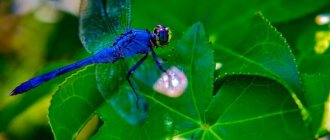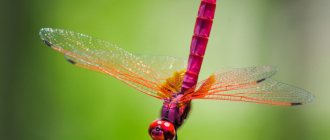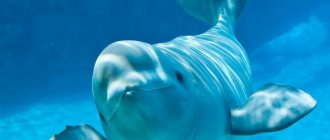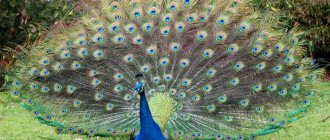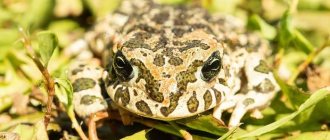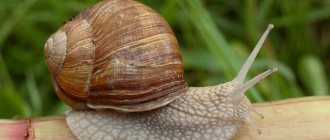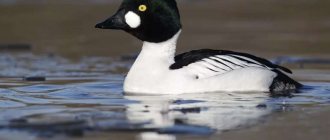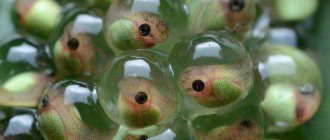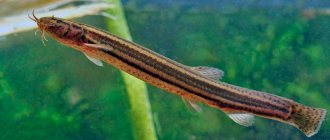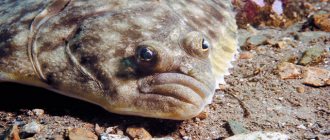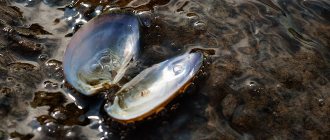XXI CENTURY Candy Fudge Scented water
266 ₽ More details
Video baby monitor Motorola MBP36S (white)
12900 ₽ More details
Women's shoes
The beautiful name of the dragonfly larva is a real mystery for many. Outwardly, it is so different from the brightly colored adult that it appears to be a different species of insect. The habitat, and therefore the way of life, is also completely different. Finding out where and how this miracle of nature lives, in order to take a look at its appearance on occasion, is very interesting and informative.
Externally, the dragonfly larva is so different from the brightly colored adult that it appears to be a different species of insect.
general information
Kazara
Dragonfly larvae (kazara)
painted in brown-olive tones. Dragonfly eggs are laid in water or in the tissue of aquatic plants. The eggs hatch into larvae of an extremely characteristic shape, interesting in their biological characteristics. These larvae play an important role among other living material of freshwater excursions.
Dragonfly larvae are found everywhere in standing and slowly flowing water. Most often they are found on aquatic plants or on the bottom, where they sit motionless, sometimes moving slowly. There are species that burrow into mud. All larvae can be divided into three groups:
- Larvae of the rocker dragonfly type (Aeschna
) with an elongated body and a flat mask. This includes the largest species that are similar to each other. In the northern regions there are representatives of the genera: Gomphus - grandfather, Onychogomphus, Gordulegaster, etc. - Larvae of the common or true dragonfly (Libellula) type
with a shorter and wider body than the previous ones. The mask is helmet-shaped. They stay mainly at the bottom, often in a layer of silt. The following genera are typical for the northern regions: Libellula - true dragonfly, Cordulla - grandma, Leucorrhinia, Epitheca (Fig. 206), Sympetrum, etc. - Larvae of the lute type (Agrion)
with a very long elongated body, which has leaf-shaped gill plates at the rear end. We have representatives of the genera: Agrion - arrows, Lestes - lyutki, Erythromma (Fig. 207), Calopteryx - beauties, etc.
Titles
The larvae of some groups of animals have special names. Usually, when talking about a species of animal, without specifying the stage to which it belongs, or when talking about a species as a whole, the name of the adult form is used, for example: “butterflies are an order of insects with complete metamorphosis.”
| Larva name | Animals |
| Insects | |
| Caterpillar | Butterflies (Lepidoptera) |
| false caterpillar | Sessile bellies (Symphyta) |
| Nymph | All insects with incomplete metamorphosis - hemipterans, orthoptera, mantises, dragonflies, etc. |
| Wireworm | Click beetles |
| Other invertebrates | |
| Glochidia | Freshwater mollusks of the pearl mussel (Unionidae) and pearl mussel (Margaritiferidae) families |
| Trochophore | Free-swimming (planktonic) larvae of a number of marine animals. They have several rows of cilia that aid in feeding |
| Nauplius | A type of larva in many crustaceans that uses head appendages for swimming |
| Vertebrates | |
| Tadpole | Tailless amphibians |
Sawfly larva Tenthredo marginella (false caterpillar)
Description
When we are near bodies of water in the summer, we are all accustomed to seeing colorful dragonflies scurrying back and forth. This shy insect, which is almost impossible to catch with your hands, is often prey for fish that hunt in the surface layer of water. A dragonfly's habit of landing on twigs or lily pads that have fallen into the water, or simply a desire to fly too close to the surface, can be fatal. Bleak, chub, trout - all these fish are not averse to eating dragonflies. But few people know that much more often the victim of hungry fish is not the dragonfly itself, but its larva.
The larvae of each dragonfly species have their own unique shape. Frankly speaking, their appearance is not particularly pleasing to our eyes with beauty. Some of the dragonflies have creepy-looking nymphs - this is the scientific name for the larval stage of insect development. Traditionally, dragonfly larvae live and develop in reservoirs or parts of reservoirs with standing water, often silted, overgrown with aquatic vegetation, or swampy. Moreover, they easily survive both in completely fresh water bodies and in brackish ones. Depending on the species, nymphs can live burrowing deep into the muddy bottom, or move in the mud near the surface, or along the bottom itself, crawling along it with enviable leisureliness. Many species also live in thickets of aquatic vegetation, where it is easier for them to hide from external enemies. Depending on the habitat, the color of the nymphs varies - from yellow to almost black.
Development and reproduction
The development of dragonflies, unlike other insects, is characterized by incomplete transformation - there is no pupal stage. Some species living in southern latitudes are capable of producing several generations per year. The mating process takes place right in the air and lasts from a few seconds to 2-3 hours.
After fertilization, the dragonfly lays eggs directly on water, plants and other floating objects. Females of some species are able to dive under water to a depth of 1 meter, remaining dry, thanks to the air bubble that surrounds the body.
Stages of development:
- Eggs are round or elongated. Their color can vary from light yellow to brown, and their number can range from 250 to 500 pieces. Sometimes they are covered with a special mass that resembles jelly, or are collected in strands.
- The larvae can also be called nymphs or naiads. They differ significantly from adult individuals, which is associated with an underwater lifestyle. It is worth paying special attention to the head, which is generally no different from the imago, with the exception of the oral apparatus. The lower lip of the insect is a unique grasping device designed for effective catching of prey - a mask. When capturing food, it opens very quickly, pierces the victim with sharp edges and pulls it to the mouth. Breathing is carried out using gills. During development, the nymph goes through a cycle of several molts, gradually developing and changing.
- Imago is the final stage of life. By the time of the last molt, the insect is already able to breathe air. Under its shell there is an almost formed individual. Before shedding its cover, the larva climbs out of the water onto a plant and sits motionless on it for several days. The old shell bursts, and a fully formed dragonfly emerges.
Dragonflies are the most common predators of the air, capable of absorbing everything indiscriminately. Cannibalism is quite widespread among these insects. Larger individuals easily attack small ones.
Method of obtaining larvae
For prey, geese use a kind of “mormyshnitsa”. The device is a metal tube with a diameter of 15-20 cm and a length of 20-30 cm, one side of it is tightly welded and a mount for a wooden handle (like a shovel) is welded to it. The other side is cut slightly at an angle to the length, and holes with a diameter of about 1 cm are drilled in rows in the walls of the tube.
Dragonfly larvae are dug for fishing 1-3 days in advance. To do this, they look for banks with steep muddy ravine. The jig is stuck into such a bank, at a depth of 0.3-1 m under water, and then, filled with silt, it is raised to the surface. And at the water's edge, they pick out the silt with their hands, pouring water on it. In the silt, you can’t even see the larva, but when doused with water, it begins to flutter and is quickly transferred to a jar of water.
Natural enemies of dragonflies
Due to the fact that larvae and adult insects live in different environments, their enemies are also different. The danger for larvae is:
- predatory and omnivorous fish;
- birds living on shallows and near bodies of water (herons, waders, etc.);
- swimming beetles and their larvae;
- some species of water bugs.
Adult dragonflies are hunted by:
- orb-weaving spiders, tetragnathid spiders, hobo spiders;
- blackflies;
- birds (including bee-eater, white wagtail, gulls, ducks, swifts, woodpeckers).
Enemy of the dragonfly
In addition, dragonflies can become prey for carnivorous plants. Most often these are varieties of sundews growing in sphagnum and peat bogs. To date, no enemies of dragonflies have been found among mammals and reptiles.
Considering that adult insects are quite cautious, fly quickly and maneuver deftly in the air, it is not easy to catch them. A predator can eat a dragonfly only if it takes the insect by surprise, which does not happen often.
Fishing with kazara
The most promising time for using goosefish as bait is from the beginning of June to the end of September. When fishing with a float rod, anglers who fish with maggots have a significantly larger catch than anglers who fish with dung worms or maggots.
When placing this bait on a hook, the hook tip is threaded through the body, starting from the head of the larva. You can start planting from the head. As you prefer. It is advisable to place several small larvae on one hook.
The larvae are great for catching ide, fairly large perch, silver bream, chub and many other fish.
Families
The table shows the main characteristics of some families.
| Name | Features, size | Wings, their size, flight | Color | Habitat |
| Beauties | Small, graceful, up to 5 cm | Homoptera, up to 7 cm. Flight like a butterfly | Blue, purple, green, with a metallic sheen | Small forest ponds, rivers and streams with quiet flows |
| Arrows | Very small, thin, up to 3 cm | Homoptera, up to 5 cm. Slow flight | Bluish-black, with thin blue rings | Stems and roots of aquatic plants |
| Real (they include the common dragonfly) | Medium, powerful, short, up to 6 cm | Various winged, up to 8 cm | There are dark triangular spots at the base of the wings. Flathead dragonflies: brownish-yellow chest, males have a blue abdomen. Eyes of different shades of green. Blood dragonflies: shades of red, brown, orange, yellow | Ponds, quiet rivers, coastal sand |
| Grandfathers | Medium, with a long flight, up to 6 cm | Various winged, up to 7 cm | Variegated, black and yellow | Flowing reservoirs |
| Cordulegasteridae | Large, up to 8 cm | Various winged, up to 10 cm | With black and yellow stripes | Forest glades, lakes, rivers |
| Rocker arms | The largest, up to 9 cm, hardy | Various winged, up to 11 cm | The chest is green, the abdomen is blue, with spots | Stagnant, dry ponds, rotting plants |
Nutrition
Dragonflies feed on a wide variety of insects. Their diet also includes blood-sucking animals: midges, mosquitoes, horseflies. The body shape of these creatures, which helps them fly beautifully, also provides them with significant service during hunting.
Dragonflies tend to attack their victims from below, overtaking them in the air. There is an explanation for this, because against the background of the sky, the visual organs of these predators, which actively react to ultraviolet and blue colors, are able to perceive objects best.
Data are naturally endowed with a powerful mouth and serrated jaws, which helps them deal with prey. And its capture is facilitated by special claws, hard hairs on the legs and short antennae.
Dragonflies can eat weak members of their species
In an effort to get food for itself, the dragonfly
capable of engaging in single combat with an opponent larger than her. These creatures are very voracious, which brings considerable benefit by exterminating mosquitoes, flies and harmful insects.
They start hunting at dawn, and as soon as the sun sets, they settle down to sleep on the leaves of plants.
Fact #2: Dragonflies are effective hunters
Dragonflies are incredibly efficient, capturing their prey 95% of the time. By comparison, sharks, one of nature's fiercest predators, manage to catch only half of the prey they hunt. Lions - “sharks on earth” - are luckier - they hit more than half of their targets. At the same time, lions move along the savannah in zigzags following their prey, without thinking through the trajectory of its movement. If dragonflies were big enough to hunt gazelles, then lions would starve to death because they would be clearly ineffective.
When a dragonfly sees its prey, it almost always catches it.
Not only operating systems, but also insects can multitask.
Habitat
All animals settle in places where conditions are favorable for them.
Dragonflies live almost everywhere. But the main factor in their habitat is the humid climate. Therefore, you can find dragonflies near rivers and lakes. A wide variety of them live in tropical and subtropical climates.
The main habitat of lice is the hair of people and animals.
Many people wonder whether lice live in other places? Yes. They can settle, for example, on fabrics, such as body louse. Being parasitic on living beings, lice cannot settle under the skin.
Beetles live everywhere.
There are especially many of them in the tropical regions of the planet. You cannot find them in the Arctic and Antarctica. They live in small numbers on mountain tops. Bed bugs also live everywhere.
Some species can be found even beyond the Arctic Circle.
Popular message topics
The Renaissance chronologically covers the period from the 14th to the 16th centuries and represents a whole movement in literature, music, painting, and architecture. It replaced the Middle Ages and is radically different from it.
One of the most popular gods of the mysterious country of the pyramids was Osiris. In Egyptian, his name sounds different - Uzis, but Osiris (translated as the only and powerful one) is an interpretation from Latin that has become more widespread.
Being tanned is very fashionable these days. Many girls and even men want to have beautiful dark skin. To do this, some people sunbathe, visit a solarium, or use special creams.
Source
Structural features
The same parts of the body can perform completely different functions in different animals. They depend on the animal’s lifestyle and environmental conditions.
Structural features of dragonflies
The eyes of dragonflies have a complex structure.
Their good vision is due to the fact that their upper part recognizes the shape of objects, and the lower part recognizes colors. To ensure the strength of the wings, veins are located along their entire length, and at the end you can see dark spots that reduce vibration during flight, thereby preventing wing fracture.
Dragonflies can make various beats of their hind and front wings for balance and synchronized ones for speeds that can reach 50 km/h. The lower lip is well developed and very long. It allows you to deftly grab prey. To hunt, the dragonfly compresses its legs while flying.
Features of the structure of lice
Lice have a sucking type oral apparatus, represented by two tubes: one for piercing the skin, and the second for sucking blood.
Another feature of the structure of lice is that during a puncture, a substance is released that stops blood clotting. The structure of the eyes is simple.
They may be completely absent. This suggests that lice do not use vision to move; their sense of smell helps them in this. This structure of lice is determined by their parasitic lifestyle.
Structural features of beetles
The main feature of beetles is their wings. They are double: the upper pair hardened during evolution and formed a chitinous shell, while the lower pair remained transparent and veiny.
This structure protects the beetle's body. They have a chewing-gnawing mouthparts.
Features of the structure of bedbugs
Bedbugs have glands on their chests that secrete an odorous enzyme. It is unpleasant to humans and resembles the smell of almonds. It serves to scare away enemies.
Interesting answers
The Kingdom of Denmark is located in the northwestern European part on the Jutland Peninsula, where in its east there are small coves and bays
The history of the development of technology is one of the most interesting branches of human history, in which every person can trace the thorny path along which every device and invention passed before it became so
1770 - Ludwig van Beethoven was born in the city of Bonn into the family of a musician. His father and grandfather were singers. Ludwig's first music lessons were given by his father. By the age of eight, the boy played the violin, organ and harpsichord.
Mendeleev created the periodic system of chemical elements, where he indicated all the possible substances that exist on the planet. In the same table you can see information about the most important substance in the life of all living beings - oxygen.
The Great Patriotic War is undoubtedly the most terrible and sad page in the history of Russia. Tens of millions of people gave their lives for the sake of a peaceful sky above their heads.
Source
